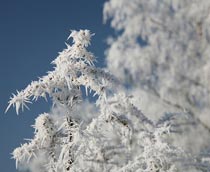
Friends and Foes - Physiological Disorders
Generally speaking a physiological disorder is a problem caused by something other than a pest or a disease. For instance, it might be that the plant is not getting enough nutrients or it might be getting too much water.
You will find that the weather always has a role to play and, despite your best efforts, too much or too little water or warmth can ruin the best laid plans. Don't despair! Most plants have a tremendous capacity to recover from adversity and even if they don't there is always next year.
Although we can't control the nutrients or weather in your garden we can help to inform you of what can go wrong and what to do to remedy the situation.
- Nitrogen is often in limited supply because it tends to be washed through the soil more quickly than other elements.
- Annual replenishment using artificial fertilizer is often required.
- In the case of very fast growing plants like tomatoes and cabbages it is often necessary to provide additional nitrogen at intervals throughout the growing season.
- These radishes have grown 'too much top and too little bottom' because of an excess of a major nutrient.
- This is not likely to be a long-term problem because the nutrient is washed out of the soil very quickly.
- Sometimes the nutrient is washed out of farmland in large quantities and then causes a problem in river water.
- Care should be taken with artificial fertilizers to ensure that they are not over used.
- We want you to know about wilting. You already know how miserable a plant looks when it is wilting so we thought we would show you a happy sunflower instead!
- Wilting occurs when a plant's inner workings cannot keep pace with what is happening around it.
- When a plant is just a little unhappy it will wilt during the hottest part of the day and recover when it gets cooler.
- There are many different reasons why plant foliage goes yellow but iron deficiency produces some of the most striking results.
- The chemical symbol for iron is Fe.
- Within a plant, iron is required in tiny quantities but without it the plant cannot function properly.
- The most common cause of iron deficiency is soils that are too alkaline (above ph 6.5).
- Do not attempt to grow acid loving plants (like azaleas and rhododendrons) if your soil is alkaline.
- At Altnaharra in Sutherland in 1995 the temperature went down to the lowest ever recorded in the UK (minus 27.2oC).
- The foliage of plants damaged by frost looks soggy when the plants thaw out and it then turns dark green or black.
- Different plants will tolerate varying degrees of frost.
- Fleece laid over delicate plants offers some protection.
- If possible, make sure that frosted plants thaw out slowly - protect from bright early morning sunshine.
- Magnesium deficiency has similar symptoms to iron deficiency but with the former the chlorosis is most noticeable on the older leaves.
- In severe cases the foliage might go brown, purple or red.
- Too much potassium in the soil can lead to magnesium deficiency.
- The problem can be remedied by spraying the plants with Epsom salts.
- Damage is most often seen on tomatoes but marrows, melons and peppers can also be affected.
- Often occurs when the plants are under stress because of lack of water.
- Excessive use of nitrogen and potassium fertilizers will exacerbate the problem.
- Occurs more frequently in acid soils and adding lime to the soil (before planting) will often be all that is required to prevent it occurring.
- Individual spots can sometimes grow and lead to areas of the apple turning brown.
- Infected areas of fruit taste unpleasant.
- The problem normally develops at or after harvest.
- It is most prevalent following hot, dry summers.
- Caused by lack of calcium in the fruit and if this has been a problem in the past then consider spraying with calcium nitrate in the summer.
- Hail forms in thunderclouds (cumulonimbi clouds) when conditions are conducive.
- Tiny lumps of ice that often occur in rainstorms are not classified as hail unless they are at least 5mm (0.2 inches) across.
- Hail can cause considerable damage to crops in the UK and on occassions it can even damage property and vehicle paintwork.
- There is little opportunity to protect crops because hailstorms develop quickly and without warning.
- Gentle rain is the lifeblood of the garden but you can have too much of a good thing as the residents of Seathwaite will tell you!
- In the drier eastern parts of the country we get an average of about 75cms of rain per year whilst western regions often get twice this amount.
- Waterlogging can easily kill plant roots so in extreme conditions try to dig trenches to drain water away from your most valuable crops.
Ready for more?
not all...
quizzers. Try to win a coveted spot on our Hall of Fame Page.

















